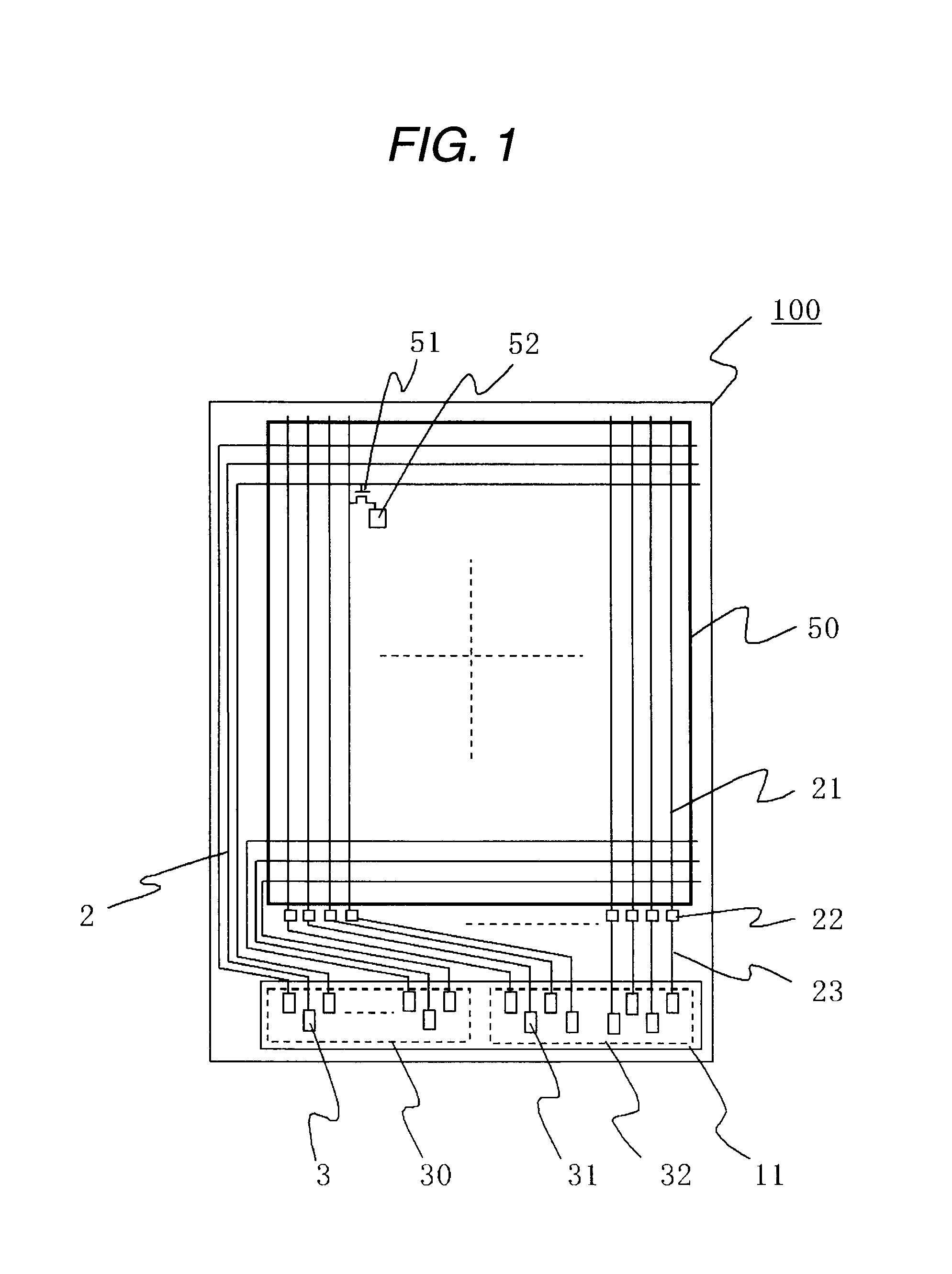Mounting terminal substrate and display device using the same
- Summary
- Abstract
- Description
- Claims
- Application Information
AI Technical Summary
Benefits of technology
Problems solved by technology
Method used
Image
Examples
first embodiment
[0022]FIG. 1 is a plan view showing the general configuration of a mounting terminal substrate of a liquid-crystal display device of a first embodiment. FIG. 2 is a plan view showing a gate mounting terminal area of the mounting terminal substrate of the first embodiment. FIG. 3 is a cross-sectional view taken along cutting plane A-A shown in FIG. 2.
[0023]In FIG. 1, a pixel area 50 is provided in amounting terminal substrate 100 which constitutes a portion of the liquid-crystal display device and opposes a color filter substrate by way of a liquid-crystal layer. A plurality of gate lines 2 and source lines 21, which intersect at right angles, are provided in the pixel area 50, and a switching element 51 formed from a thin-film transistor, or the like, and a pixel electrode 52, or the like, are formed in a pixel (only one pixel is illustrated) located at each of the intersections. The plurality of gate lines 2 and the source lines 21 are drawn from the pixel area 50. A gate mounting ...
second embodiment
[0056]A second embodiment relates to a configuration of the top layer of the insulation film 4 being the organic resin film 4c and the upper conductive film 7 being ITO. ITO formed on an organic substance differs from ITO formed on an inorganic substance in terms of film quality and an etch rate. An etch rate of the ITO formed on an organic substance is two to eight times as high as an etch rate of the ITO formed on an inorganic substance.
[0057]Since the two types of ITO greatly differ from each other in terms of an etch rate, etching of ITO must be divided into two operations in the first embodiment in order to process, with superior dimensional accuracy, the pixel electrodes 52 made from ITO formed on the organic resin film 4c and the upper conductive film 7 made from ITO. After etching of the pixel electrodes 52 whose etch rate is high, the ITO still remaining on the glass substrate 1 within the opening sections 5 is removed by means of additional etching while the pixel electrod...
third embodiment
[0061]FIG. 7 is a cross-sectional view showing a gate mounting terminal area of a third embodiment. An inorganic insulation film 4d formed from an oxide film or a nitride film is formed additionally on the organic resin film 4c forming the insulation film 4. The top layer of the insulation film 4 is formed as the inorganic insulation film 4d, thereby rendering the etch rate of the pixel electrodes 52 and the etch rate of the upper conductive films 7, which are formed from different types of ITO, uniform and enhancing dimensional accuracy. Since ITO is formed on the inorganic substance by means of such a configuration, the etch rate becomes low. However, an advantage of the ability to form the pixel electrodes 52 and the upper conductive films 7 in their originally-designed positions by means of single etching of ITO without involvement of the remaining ITO films 7a is yielded with superior accuracy.
[0062]Incidentally, the organic resin film 4c adjoins respective side surfaces of the...
PUM
 Login to View More
Login to View More Abstract
Description
Claims
Application Information
 Login to View More
Login to View More - R&D
- Intellectual Property
- Life Sciences
- Materials
- Tech Scout
- Unparalleled Data Quality
- Higher Quality Content
- 60% Fewer Hallucinations
Browse by: Latest US Patents, China's latest patents, Technical Efficacy Thesaurus, Application Domain, Technology Topic, Popular Technical Reports.
© 2025 PatSnap. All rights reserved.Legal|Privacy policy|Modern Slavery Act Transparency Statement|Sitemap|About US| Contact US: help@patsnap.com



